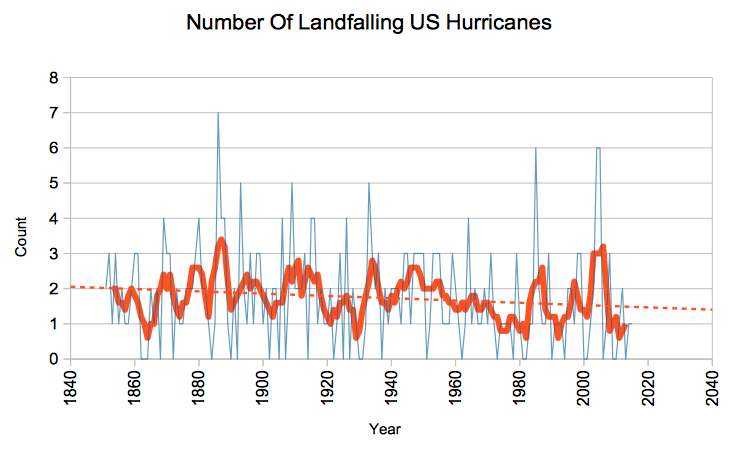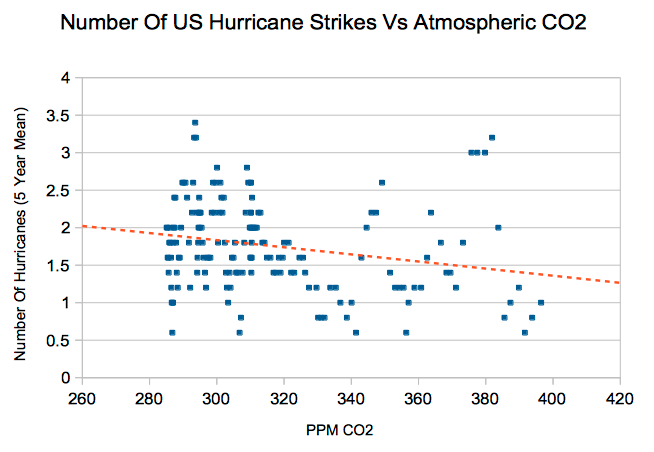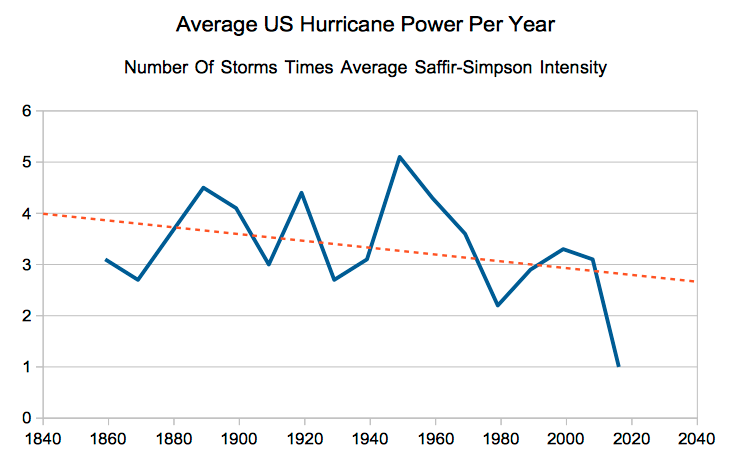30 peer-reviewed scientific papers reveal the lack of connection between hurricanes & ‘global warming’
By on 10. October 2016
Below there are 30 peer-reviewed scientific papers that summarize the literature on the lack of connection between ocean temperatures and hurricane variability. Perhaps Sutter and Mann could find these educational.
No Trend Or Reduced Intensity Of Landfalling Hurricanes With Warming
“The impact of climate change is seen in slightly decreased intensities in landfalling cyclones.”
“[T]be global frequency of category 4 and 5 hurricanes has shown a small, insignificant downward trend [1990-2014].”
“The various SST measures only have a weak influence on TMLGP[tropical cyclones making landfall, South China] intensities. Despite the long-term warming trend in SST in the WNP, no long-term trend is observed in either the frequency or intensities of TMLGP[tropical cyclones making landfall, South China].”
“A long-term (five decade) downward trend continues to be evident primarily in the frequency of intense hurricanes. In addition, the mean maximum intensity (i.e., averaged over all cyclones in a season) has decreased, while the maximum intensity attained by the strongest hurricane each year has not shown a significant change.”
“All of the counts, lifespans, and accumulated cyclone energy of the late-season typhoons during the 1995–2011 epoch decreased significantly, compared with typhoons that occurred during the 1979–94 epoch.”
“There has been no trend towards an increase in the number of categories 3–5 cyclones over the last 30 years.”
“Extratropical cyclones cause much of the high impact weather over the mid-latitudes. With increasing greenhouse gases, enhanced high-latitude warming will lead to weaker cyclone activity. Here we show that between 1979 and 2014, the number of strong cyclones in Northern Hemisphere in summer has decreased at a rate of 4% per decade, with even larger decrease found near northeastern North America.”
“[D]ata show a decrease in the proportion of category 4-5 typhoons from 18% to 8% between the two periods of 1977-1989 and 1990-2004 (Table 1; intensity estimates in terms of sustained maximum winds first became available in RSMC-Tokyo best track data in 1977).”
…“No significant correlation was found between the typhoon activity parameters and local SST [during 1960-2003]. In other words,an increase in local
America’s most influential enviro McKibben: Use America’s defense budget to fight climate war
Via The HARRY READ ME File: Described by the Boston Globe as “America’s most important environmentalist”, 350.org founder Bill McKibben says America’s defense budget must “be put to work defending us against the most dangerous adversaries we face” — climate change.
BILL MCKIBBEN: “It should be possible to build large quantities of solar panels and turbine blades, and it should be possible to put lots of people at work on good jobs doing that, okay? And it should be a huge priority, and if you think we don’t have the money then you’re not paying attention. We have things like the defense budget that need to be put to work defending us against the most dangerous adversaries we face. The conceit of that New Republic piece was that we are in fact already at war though we do not really recognize it. But, by all the measures that we normally count as warfare, that’s what’s going on. We’re losing territory day by day. People are being killed day by day in great numbers. There will probably be added to that death toll tonight someplace along the coast of Florida. We’re at war, we’re just not fighting back, and the time has come to do that, and it will take as the history of WWII shows, government leadership to make that happen. It will take a concentrated national effort and a concentrated international effort to make that happen. It won’t happen on its own, it requires leadership.”
Bill McKibbin: The Hottest Fight in the Hottest Year
Oberlin College
Oberlin, Ohio
October 6, 2016…
US Hurricanes Continue Their Decline: ‘Peaked in 1886…Declining ever since – as CO2 has increased’
The number of hurricanes striking the US peaked in 1886, and have been declining ever since – as CO2 has increased.
As CO2 has increased, the number of hurricanes hitting the US has decreased
The total hurricane intensity is also declining.
There is no evidence linking hurricanes to CO2,
Extreme Weather Expert: ‘Incredible streak of no-US major hurricanes (Cat 3+) continues – 4,001 days & counting
…No New Record? UAH Data Show 2016 Still Trails Behind 1998 Record Warm Year
By Schneefan
Already in August, is the year 2016 a bit cooler than the year 1998, according to satellite data from UAH. That situation remains the same as September saw a reading of +0.44°C.
The global 2m temperatures with a deviation of +0.38°K eased off slightly from the August reading of 0.42°K, see the following chart:
The above UAH chart shows the monthly deviations from the mean (blue line) of the global temperatures of the lower troposphere at 1500 meters altitude (TLT) and the 13-month running average (red curve). Due to a powerful globally time-shifted El Niño event beginning in the summer of 2015, there was a record string of months from November to March. There was a strong retreat from April to June, with temperatures stagnant near 0.44°K over the past 3 months. Source: UAH Global Temperature Update for September 2016: +0.44°CC.
What follows is a direct comparison of the January – August period for both 1998 and 2016 El Niño years:…
US Winters Getting Colder, As They Get Warmer!
…German Scientists: ‘Media Are Playing A Dangerous Game With Extreme Weather Fear’
By Dr. Sebastian Lüning and Prof. Fritz Vahrenholt
(German text translated/edited by P Gosselin)
The history of science is rich in discoveries, progress, falsehoods and confusion. How will future generations see the history of climate science? Where are they going to set the point that distinguishes alarmism from reasonable science?
August 12, 2016 could be an important date on the way to answering this question. On that date Vladimir Jankovic and David Schultz of the University of Manchester published in the journal Weather, Climate and Society an important paper of great clarity and openness. In doing so, they coined an important new term: Atmosfear, the fanning of fear through the use suspected processes occurring in the atmosphere.
Jankovic and Schultz do not mince any words. They criticize the simplistic view that extreme weather is always the consequence of man’s activity and that it could be tamed simply by reducing emissions. The recent rise in extreme weather damage can be traced back almost entirely to societal factors, i.e. the increased number of insurance companies, insured values and people settling more in areas of hazard.
The paper’s abstract tells us the important points:
…Atmosfear: Communicating the Effects of Climate Change on Extreme Weather
The potential and serious effects of anthropogenic climate change are often communicated through the soundbite that anthropogenic climate change will produce more extreme weather. This soundbite has become popular with scientists and the media to get the public and governments to act against further increases in global temperature and their associated effects through the communication of scary scenarios, what we term “atmosfear.” Underlying atmosfear’s appeal, however, are four premises. First, atmosfear reduces the complexity of climate change to an identifiable target in the form of anthropogenically forced weather extremes.Second, anthropogenically driven weather extremes mandate a responsibility to act to protect the planet and society from harmful and increased risk. Third, achieving these ethical goals is predicated on emissions policies. Fourth, the end-result of these policies—a non-anthropogenic climate—is assumed to be more benign than an anthropogenically influenced one. Atmosfear oversimplifies and misstates the true state of the science and policy concerns in three ways. First, weather extremes are only one of the predicted effects of climate change and are best addressed by measures other than emission policies. Second, a pre-industrial climate may remain a policy goal, but is unachievable in reality. Third, the damages caused by
Trump Goes Off On Hillary For Saying She’d ‘Put All The Miners Out Of Business’
…Hillary Gave A Roundabout Answer About Her Energy Policies During The Debate
…Gore to appear in hurricane-battered Florida to rally millennials for Clinton
Can former vice president Al Gore, who hasn’t been on the ballot in a decade and a half, persuade young voters to back Hillary Clinton by appearing in hurricane-battered South Florida?
He and the Democratic presidential nominee will start testing this proposition Tuesday afternoon, when the two appear together at Miami Dade College.
The location has plenty of symbolic importance — the area has not only just been battered by Hurricane Matthew, it is also a part of the country most vulnerable to sea-level rise and in the state where Green Party candidate Ralph Nader helped derail Gore’s 2000 presidential candidacy.
[For millennial voters, the Clinton vs. Trump choice ‘feels like a joke’]
The 3 p.m. appearance is timed to coincide with the state’s voter registration deadline, and the Clinton campaign announced Sunday that the two politicians would urge Florida voters “to check their registration status and to get registered by October 11 to make their voices heard this election.”…




